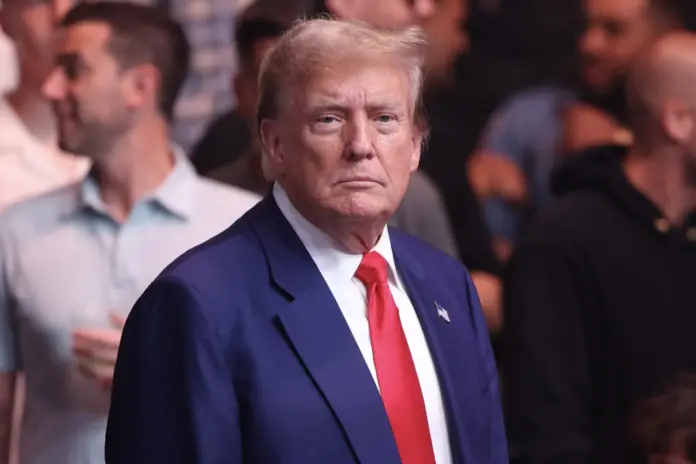WASHINGTON, Apr 03 (APP): Wide-ranging tariffs announced by US President Donald Trump riled global trading markets and drew frustrated responses from world leaders Thursday, according to media reports.
His administration imposed tariffs on imports from around the world that range from a 10% baseline tax on imports from all countries to major economies 34% on China and 20% from Europe.
Ursula von der Leyen, president of the European Commission, the EU’s executive branch, said Trump’s levies were “a major blow” that will cause rising inflation and higher bills across the globe. Von der Leyen made the remarks in a statement from Uzbekistan, where she’s attending an EU-Central Asia summit.
She said the EU was “prepared to respond” to Trump’s sweeping new levies but did not immediately announce countermeasures.
In South Asia, Pakistani and Indian companies will have to pay 26% tariff and 29% tariffs on exports to the United States.
Other nations affected did not immediately take action, but they did issue strongly worded statements that appeared to suggest a global trade war could be imminent.
Australian Prime Minister Anthony Albanese called the measure “totally unwarranted” and not what he would expect from an ally. Italy’s leader Giorgia Meloni said the tariffs were “wrong.” Ireland’s Prime Minister Michea´l Martin, known as the Taoiseach, said “We see no justification for this.” China’s ministry of commerce called for Washington to “immediately cancel” the tariffs, warning they “endanger global economic development.”
“Nobody wins in a trade war,” British Prime Minister Keir Starmer said.
Trump described the tariffs as a “declaration of economic independence” and argued they will rejuvenate the U.S.’s declining manufacturing sector and lead to more American jobs and domestic economic activity. Economists have expressed alarm over what they could mean for the U.S. and other economies around the world.
“This is a game changer, not only for the U.S. economy but for the global economy. Many countries will likely end up in a recession,” wrote Olu Sonola, the head of U.S. economic research at Fitch Ratings, in a note.
Most economic analysts define a recession as involving at least two consecutive quarters of decline in a country’s economic growth, typically marked by falling, inflation-adjusted wages and higher unemployment.
Trump’s tariffs plan represents a major shift in current U.S. trade policy. It’s not clear how long it will last. Stock markets in Asia and Europe plunged on the news and U.S. stock futures traded sharply lower.
While the plan includes a 10% baseline tariff on goods from all countries that will start on April 5, about 60 nations that Trump described as the “worst offenders” face higher rates that come into effect on April 9.
It was not immediately clear how the country-specific tariff rates were calculated by the U.S., but each country’s tariff rate appeared to be connected to its trade deficit with the U.S. Additionally, Trump said that because he’s “kind,” the final tariff number arrived at was then cut in half.
A trade deficit is when a nation’s imports are greater than its exports, meaning it’s buying more from other countries than it’s selling to them. Trump has long complained that many countries are selling far more of their goods to Americans than the U.S. is selling to citizens of the world. He seeks to address that imbalance. Economists predict that the tariffs will lead to higher prices for Americans – at least in the short-term
Trump launched a trade war with China during his first term, imposing steep tariffs on many of that country’s goods. Beijing responded with its own retaliatory tariffs on U.S. products, ranging from imports of fruit to car parts. The Biden administration kept most of the tariffs in place, and added new ones.
The tariffs are part of Trump’s economic policy that seeks to bolster U.S. manufacturing, since, in his view, “our country has been looted, pillaged, raped and plundered” by other countries in the current international trade system.
As a result, he said, “American steel workers, auto workers, farmers and skilled craftsmen — we have a lot of them here with us today — they really suffered gravely.”
The new tariffs include a 24% levy on Japan, a close U.S. partner imports and 46% on goods from Vietnam, the Far East country that has built its economy with the help of exports to the United States.
The baseline tariff announced on Wednesday is set to apply on imports from all countries on April 5 while those designed to be reciprocal on trading partners will implemented from April 9.
The new tariffs are likely to see an uptick in the trade wars with some major economies expressing concern on the future direction of the world economic growth.
Domestically, the U.S. consumers – long thought to be a key driver of the world economy – are likely to pay higher costs for on wide-ranging products of everyday use from groceries and clothes to autos and in investments in housing.
Trump justifies the “economic emergency” as the reason behind his tariff hike move with the pledge that his policies would lead to much greater investment inflows into the United States, kickstarting economic growth on a larger scale in areas like local manufacturing.
He says American taxpayers have been “ripped off for more than 50 years,” he said.
“But it is not going to happen anymore.”
“My fellow Americans, this is Liberation Day. April 2, 2025, will forever be remembered as the day American industry was reborn, the day America’s destiny was reclaimed, and the day that we began to Make America Wealthy Again,” the U.S. President said. But critics called it a “Inflation Day.”
U.S. officials say the country faces more than a trillion dollars in trade deficit due to unfair tariffs that have been in effect for decades.
On Thursday, the stock markets reacted negatively to the newly announced tariffs with Dow Jones plunging 1200 points in the morning.
APP/ift

